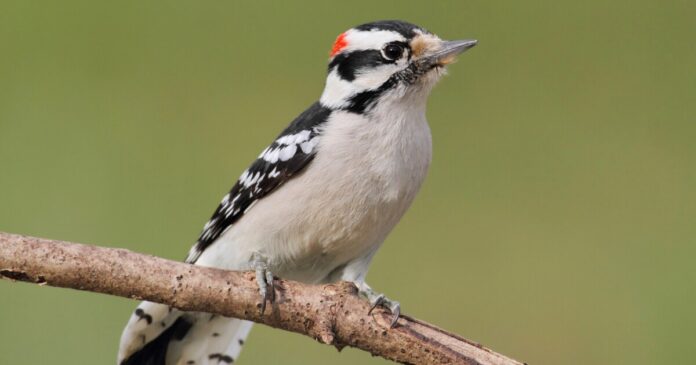Don’t be fooled by that soft-looking down and pretty faces – woodpeckers are tough, tree-pounding beasts who simultaneous harden their whole bodies like a hammer and grunt as they drill away with force of up to 30 times their weight.
Brown University researchers were interested in finding out what was happening not just in a woodpecker’s skull but across its whole body when in action. We know a fair bit about how the bird’s morphology prevents head injury when pecking at up to 20 ft/s (6 m/s), with a deceleration more than 1,000 times that of gravity. And how its super-long tongue will retract and wrap around its brain when not in use, for extra shock absorption. However, most studies have concentrated on the mechanics of the beak and head.
“We’re left to wonder, where does all the power come from?” said study co-author Matthew Fuxjager, a professor of ecology, evolution and organismal biology at Brown who has been studying woodpeckers for more than a decade. “Where does the protection come from? Those questions stimulated our study, which took a more whole-body approach.”
Nicholas Dentamaro
Here, the researchers captured eight wild downy woodpeckers (Picoides pubescens), a small species native to North America and filmed the birds over three days, recording their drilling and tapping on hardwood via high-speed camera.
They recorded electrical signals in muscles from head to tail, to see what areas were engaged while they were at work on the wood. Then in six birds they captured air-pressure data from a section of their airway, and in the two others they measured the air exhaled through their voice boxes. They matched footage, captured at 4 ms per frame, with the data and were able to make some remarkable new insights about the bird’s biology behind the behavior.
Muscle strength may not be the first physical attribute you think of when you look at smaller birds like the downy woodpecker, which weighs less than an ounce (30 g). However, the scientists discovered that muscles play a crucial role in powering their drilling motion, and it’s a team effort across the body, with the front neck, abdomen, tail and hip flexor muscles especially engaged. Essentially, when in pecking mode, the birds tensed their bodies in a way that put real force behind their drilling action – sort of like turning themselves into a hammer to strike with their beak and drive it into the wood.
“They recruit muscles across the head, neck, hips, abdomen and tail,” said lead author Nicholas Antonson, a postdoctoral research fellow in ecology, evolution and organismal biology at Brown, “essentially using their entire body to forge a coordinated hammer, with the neck stiffening on contact in a similar manner to how human wrists do when swinging a hammer.”
What’s more, the bird’s specialized one-way breathing synced up with their pecking movements, actively expelling air with force – like a grunt made by a tennis player when striking the ball – each time the beak connected with the wood. This rapid, miniature grunt helps to boost the power behind each peck.
“This type of breathing pattern is known to generate greater co-contraction of trunk musculature,” said Antonson.
During rapid periods of tapping, the woodpeckers took “mini-breaths” between each blow – the type of respiratory pattern that’s only been recorded in songbirds before. It’s the first time it’s been seen in species doing this in non-vocal communication.
“These findings expand our understanding of the links between respiration, muscle physiology and behavior to perform extreme motor feats and meet ecological challenges,” Antonson added.
Incredibly, the birds were able to strike the wood with forces measuring up to 30 times their body weight, matching each blow with their breath – up to 13 breaths per second – to act as one powerful pecking machine. The behavior is also an important tool for social communication among the birds.
“These displays that involve moving the body, either as a dance, or as a gesture, or even as a vocalization, are a way to convey information to another individual or group,” Fuxjager said. “In the case of woodpeckers pecking, they aren’t just doing a simple thing at an extraordinary speed. They are coordinating all the muscles of their body and their respiratory system to allow them to perform an impressive feat. More than speed, it’s a matter of extraordinary skill.”
The researchers point out that this sort of whole-body coordination is something humans assess in others without even realizing it.
“When you’re watching someone perform on American Idol, and you’re making judgments on whether they’re a good singer or a bad singer, you’re unconsciously assessing their vocal motor skills, and how they, too, can coordinate their body movement and their breathing to produce a physical display,” said Fuxjager.
The research was published in the Journal of Experimental Biology.
Source: Brown University


